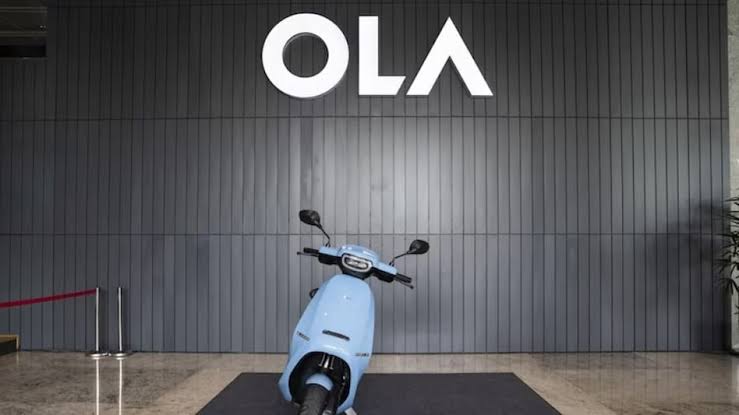Add your promotional text...
Ola Electric’s Shares Dip Below ₹100: What’s Driving the 13% Decline?
Synopsis: Ola Electric's share price has dropped by 13% over the past 30 days, falling below ₹100. The downturn follows a peak of ₹157.40 in August, driven by weakening sales and market share. Despite short-term challenges, brokerage firms like HSBC, Goldman Sachs, and BofA Securities remain optimistic, issuing "buy" ratings, while Ambit Capital takes a cautious approach with a "sell" rating. As Ola navigates market uncertainties, its product innovation and leadership in India's electric two-wheeler market are critical to its future growth.
TRENDING STOCKS
By Aman Jaiswal
9/30/20243 min read


Ola Electric, a prominent player in the electric vehicle (EV) industry, saw its stock price drop below the ₹100 mark on Monday morning. Over the past 30 days, the company’s share price has tumbled by around 13%, causing concern among some investors.
What Led to the Decline?
Ola Electric’s stock has been on a downward trajectory ever since it peaked at ₹157.40 on August 20. Several factors have contributed to this slump, with declining sales and shrinking market share being the most significant. The weakening demand for Ola's electric two-wheelers has dampened investor sentiment around the company, leading to a slide in its stock price.
Despite this, many brokerage firms remain confident in the company's long-term potential. Industry leaders such as HSBC, Goldman Sachs, and BofA Securities have issued positive recommendations for Ola Electric’s stock, reflecting optimism about the future of the electric two-wheeler market and Ola’s position within it.
Brokerage Perspectives
BofA Securities:
BofA Securities has initiated coverage of Ola Electric with a “buy” rating and set a target price of ₹145. The firm is bullish on the company’s prospects, citing its leadership in the electric two-wheeler segment and the broader growth potential of the EV market in India. BofA believes that the current dip in stock price presents a buying opportunity for investors who are willing to take a long-term view.
Goldman Sachs:
Goldman Sachs also shares a positive outlook for Ola Electric. The investment bank issued a “buy” recommendation with a target price of ₹160, underscoring its confidence in the company’s ability to capitalize on the growing demand for electric vehicles in India. Goldman Sachs sees Ola Electric as well-positioned to benefit from the shift towards sustainable transportation and the increasing focus on reducing carbon emissions.
HSBC:
HSBC, another global brokerage giant, initiated its coverage of Ola Electric with a “buy” rating and set a target price of ₹140. HSBC’s positive outlook is based on the company’s market leadership and the anticipated expansion of India’s electric vehicle market. According to HSBC, Ola Electric’s innovative product offerings and strategic market positioning make it a strong contender in the EV space.
A Cautious Approach from Ambit Capital
In contrast to the optimistic outlook of other brokerages, Ambit Capital has taken a more conservative stance on Ola Electric. The firm initiated coverage with a “sell” rating, assigning a target price of ₹99.60. Ambit’s cautious approach reflects its concerns over the company’s current challenges, particularly its declining sales and market share. The firm believes that the stock may face further pressure in the near term as the company navigates these issues.
This divergence in analyst opinions highlights the varying perspectives on Ola Electric’s potential in the electric two-wheeler market. While some believe that the company is well-positioned for growth, others remain wary of its immediate challenges.
Ola Electric’s Recent Milestones
Amid the stock market fluctuations, Ola Electric has continued to make strides in its product offerings and market development. Earlier this month, the company announced that its S1 X 2 kilowatt-hour scooter had been awarded Production-Linked Incentive (PLI) certification. This certification is a significant achievement for the company, as it positions the S1 X 2 kilowatt-hour as the fifth product in Ola Electric’s portfolio to receive PLI benefits. The PLI certification is part of the Indian government’s initiative to promote domestic manufacturing of electric vehicles and reduce dependence on imports.
Ola Electric’s continued focus on innovation and product development is seen as a positive sign by many industry analysts, who believe that the company’s ability to introduce new, efficient models will help it maintain its market leadership in the long run.
Price Movement
As of Monday morning, Ola Electric’s share price was down 2.77%, trading at ₹99.35 shortly after the market opened. This drop below ₹100 marks a significant milestone for the company’s stock, which had previously reached record highs just a month earlier. The price movement reflects the broader uncertainty in the market regarding the company’s future performance.
In conclusion, Ola Electric’s stock has faced considerable challenges in recent weeks, with declining sales and market share contributing to the downturn in its share price. However, despite the short-term difficulties, many analysts remain optimistic about the company’s long-term prospects. Leading brokerage firms like HSBC, Goldman Sachs, and BofA Securities have issued “buy” recommendations, reflecting their confidence in the company’s ability to recover and grow within the expanding electric two-wheeler market.
At the same time, more cautious voices, such as Ambit Capital, have raised concerns about the company’s near-term performance, leading to a divergence in market opinions. As Ola Electric continues to innovate and expand its product portfolio, its ability to address these challenges will be crucial to its future success in the competitive EV market.
For investors, the current situation presents both risks and opportunities. While the stock’s recent decline may be concerning, the overall outlook for the EV industry in India remains positive, and Ola Electric’s leadership in the two-wheeler segment positions it well to capitalize on future growth opportunities.
